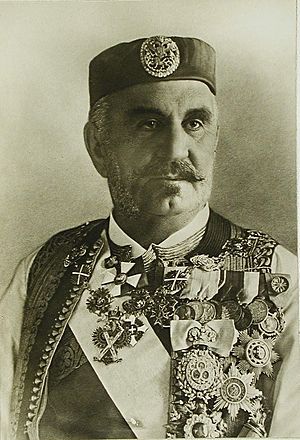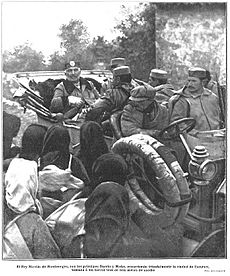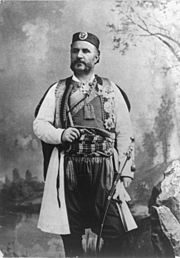Nicholas I of Montenegro facts for kids
Quick facts for kids Nikola IНикола I |
|||||
|---|---|---|---|---|---|
| King of Montenegro Prince of Montenegro Grand Duke of Grahovo |
|||||

Nicholas I c. 1910s
|
|||||
| King of Montenegro | |||||
| Reign | 28 August 1910 – 26 November 1918 | ||||
| Predecessor | Himself (as Prince of Montenegro) | ||||
| Successor | Title abolished | ||||
| Prince of Montenegro | |||||
| Reign | 13 August 1860 – 28 August 1910 | ||||
| Predecessor | Danilo I | ||||
| Successor | Himself (as King of Montenegro) | ||||
| Born | 7 October 1841 Njeguši, Montenegro |
||||
| Died | 1 March 1921 (aged 79) Cap d'Antibes, France |
||||
| Burial | 1 October 1989 Court Church, Cetinje, Montenegro |
||||
| Spouse |
Milena Vukotić
(m. 1860) |
||||
| Issue |
List
|
||||
|
|||||
| House | Petrović-Njegoš | ||||
| Father | Mirko Petrović-Njegoš, Grand Voivode of Grahovo | ||||
| Mother | Anastasija Stana Martinović | ||||
| Religion | Serbian Orthodoxy | ||||
| Signature | |||||
Nikola I Petrović-Njegoš (born October 7, 1841 – died March 1, 1921) was the last ruler of Montenegro. He was a prince from 1860 to 1910. Then, he became Montenegro's first and only king from 1910 to 1918. He led his country through many changes and wars.
Contents
Biography of Nikola I
Early Life and Education
Nikola was born in Njeguši, a village where the ruling House of Petrović family lived. His father was Mirko Petrović-Njegoš, a famous Montenegrin warrior. Nikola's uncle, Danilo I, was the ruler before him. For a long time, the rulers of Montenegro were church leaders called vladikas, who could not marry. But Danilo I changed this, making the rule pass from father to son. Nikola was chosen to be the next ruler.
Nikola was trained from a young age in fighting and sports. He also spent some time in Trieste with his aunt. Later, he went to a special school in Paris, France. Even though he studied in Paris, Nikola loved his home country very much. He was a strong patriot and showed early talent for leadership and writing poems.
Nikola was part of a group called the "United Serbian Youth" from 1866 to 1871. After this group was banned, he helped start the "Association for Serb Liberation and Unification" in Cetinje in 1871. Nikola also wrote a famous Serbian patriotic song called "Onamo, 'namo!" and a play called "Empress of the Balkan".
Becoming Prince of Montenegro
While still studying in Paris, Nikola became the prince of Montenegro on August 13, 1860. This happened after his uncle Danilo I was assassinated. Nikola was only 19 years old. On November 8, 1860, he married Milena, who was 13. She was the daughter of a leader named Petar Vukotić.
After becoming prince, Nikola made many important changes. He improved the military, how the country was run, and education. Montenegro fought several wars against the Ottoman Empire between 1862 and 1878. In 1867, he met Emperor Napoléon III in Paris. In 1868, he visited Russia and was warmly welcomed by the tsar, Alexander II. He also visited the royal families in Berlin and Vienna.
His visits helped Montenegro a lot. The Russian tsar and empress gave money for schools and other projects. They also sent weapons and ammunition to Montenegro. In 1871, a Russian prince visited Montenegro and gave a lot of money to the people. Nikola was a strong leader. In 1869, he stopped his people from helping a revolt against the Austrian government. He also calmed down excitement when the Greco-Turkish War started in 1897.
In 1876, Nikola declared war on Turkey. He gained a good reputation as a military leader during this war and another one in 1877-78. During these wars, he captured important cities like Nikšić, Bar, and Ulcinj. The wars helped Montenegro gain more land and a coastline on the Adriatic Sea. Nikola said the war was revenge for the Battle of Kosovo in 1389. He wanted to see the Serbian Empire rise again.
In 1878, the Congress of Berlin officially recognized Montenegro as an independent country. In the years that followed, Montenegro became more successful and stable. Education, communication, and the army grew a lot, with help from Imperial Russia. In 1883, Prince Nikola visited the Sultan of the Ottoman Empire, and they had a friendly relationship. In 1896, he celebrated 200 years of the Petrović family ruling Montenegro. He also attended the coronation of Nicholas II and visited Queen Victoria at Windsor Castle in 1898.
Becoming King of Montenegro
| Styles of King Nikola I |
|
|---|---|
 |
|
| Reference style | His Majesty |
| Spoken style | Your Majesty |
In 1900, Nikola started using the title Royal Highness. In 1905, he gave Montenegro its first constitution. This happened because people wanted more freedom. He also brought in press freedom and new criminal laws. In 1906, Montenegro got its own money, called the perper.
On August 28, 1910, during a celebration of his 50 years as ruler, Nikola officially became king. This was requested by the Montenegrin assembly. At the same time, he was made a field-marshal in the Imperial Russian Army, a very special honor.

When the Balkan Wars started in 1912, King Nikola was very eager to fight. He wanted to remove the Ottomans completely from Europe. He even went against other European powers and captured Scutari, even though they tried to stop him. In the Great War (which started in 1914), he was the first to help Serbia fight against the Austro-Hungarian Empire.
In January 1916, Montenegro was conquered by Austria-Hungary. King Nikola had to flee to Italy and then to France. After World War I ended, a meeting in Podgorica decided to remove Nikola from the throne. They also voted to join Montenegro with Serbia. A few months later, Serbia (including Montenegro) joined with other South Slav lands to form the Kingdom of Serbs, Croats and Slovenes. This country was later renamed Yugoslavia.
Nikola lived in exile in France from 1918. He continued to say he was the rightful king until he died in Antibes three years later. He was first buried in Italy. In 1989, Nikola, his queen Milena, and two of their children were re-buried in Montenegro.
Nikola I's Children
Nikola had many children. Five of his daughters married princes and kings from other countries. Because of this, Nikola was sometimes called "the father-in-law of Europe". He shared this nickname with the King of Denmark at the time.
Here are some of his children:
- Princess Zorka of Montenegro (1864–1890): She married Prince Peter Karađorđević, who later became King Peter I of Serbia. They had five children.
- Princess Milica of Montenegro (1866–1951): She married Grand Duke Peter Nicolaievich of Russia. They had four children.
- Princess Anastasia of Montenegro (1868–1935): She married twice, both times to Russian Grand Dukes.
- Princess Marija of Montenegro (1869–1885): She died young at age sixteen.
- Danilo, Crown Prince of Montenegro (1871–1939): He was the Crown Prince, meaning he was next in line to be king. He married Duchess Jutta of Mecklenburg-Strelitz. They had no children.
- Princess Elena of Montenegro (1873–1952): She married Crown Prince Victor Emmanuel, who later became King Victor Emmanuel III of Italy. They had five children.
- Princess Anna of Montenegro (1874–1971): She married Prince Franz Joseph of Battenberg. They had no children.
- Princess Sofia of Montenegro (1876–1876): She died as a baby.
- Prince Mirko of Montenegro (1879–1918): He married Natalija Konstantinović. They had five sons.
- Princess Xenia of Montenegro (1881–1960)
- Princess Vjera of Montenegro (1887–1927)
- Prince Peter of Montenegro (1889–1932): He married Violet Emily Wegner.
Today, the person who would be king if Montenegro still had a monarchy is Nikola's great-grandson, Prince Nikola.
Honours and Awards
King Nikola I received many important awards and honors from different countries around the world. These awards showed the respect and alliances he had with other nations. He was recognized for his leadership and his role in Montenegro's history.
See also
 In Spanish: Nicolás I de Montenegro para niños
In Spanish: Nicolás I de Montenegro para niños



